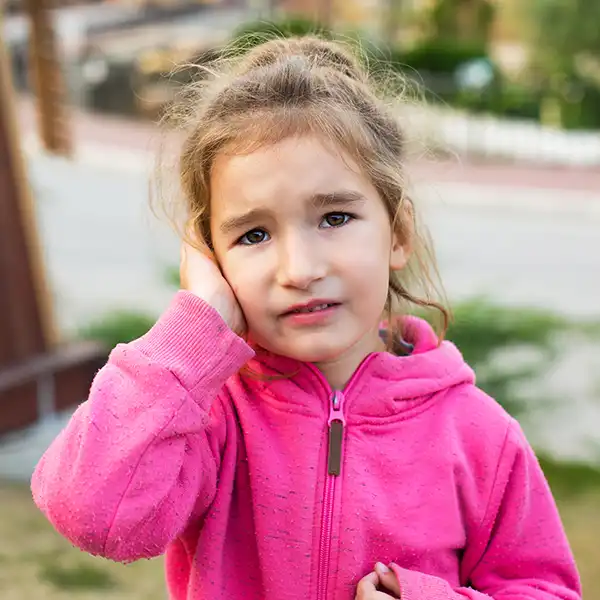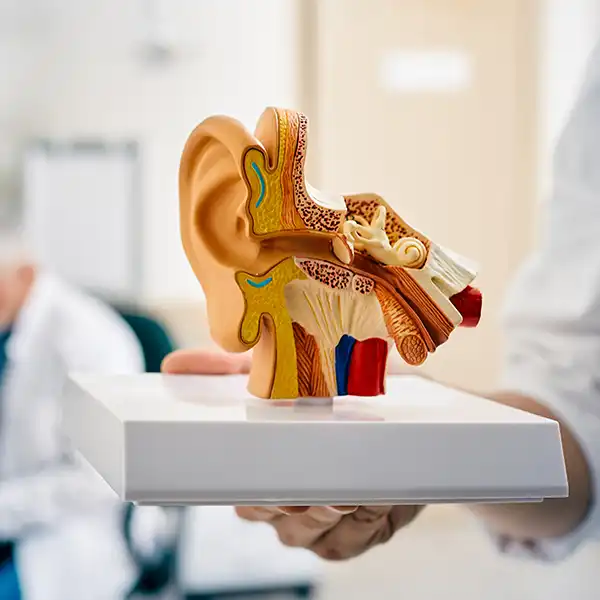Ear Grommets Surgery
What are ear grommets?
Grommets are tiny tubes that are inserted into the eardrum to help treat common childhood middle ear conditions, such as recurrent acute otitis media, glue ear, and Eustachian tube dysfunction.
Repeated ear infections can cause thick, sticky fluid to collect in the middle ear space, leading to pain, hearing loss, and recurring ear infections (otitis media). Grommets allow air to flow into the middle ear which equalises pressure and helps relieve fluid from the middle ear and the Eustachian tube return to normal function.
Also known as tympanostomy tubes or middle ear ventilation tubes, grommets can be made of plastic or silicone. They are inserted into the affected ear through a small incision in the eardrum. This is a minimally invasive procedure that can be performed under local anaesthetic in adults, but is usually performed in hospital under general anaesthetic in children.
Most children recover quickly from the surgery and ear grommets cause no discomfort while in place. They typically stay in the child’s ear for about six to 12 months, after which time the grommets will naturally fall out as the eardrums heal.
Which conditions can be treated with ear grommets?
Acute otitis media is an infection caused by viral or bacterial agents that can result in pain, fever and pus in the middle of the ear with an inflamed eardrum. Occasionally, the eardrum may also burst, resulting in ear discharge.
Acute otitis media is one of the most common illnesses for children, with nearly every child having experienced a middle ear infection by the age of five. Most children grow out of their ear infections, but this can occur at different ages.

Otitis media is recurrent when the infection occurs three or more times in six months. Repeated middle ear infections are more likely to develop:
- in children prone to upper respiratory infections
- when fluid is still present in the middle ear space from a previous infection
- in children who attend day care
- where the eustachian tube does not function properly
Otitis media which has been present for three months or more with the accumulation of fluid in the middle ear (effusion) is called glue ear. The fluid is often thick and sticky with a similar consistency to glue.
Contributing factors that are most commonly associated with glue ear include:
- poor Eustachian tube function
- attending day care
- children under the age of three
- a previous middle ear infection
- frequent viral infections which occur during winter months
- structural problems such as a cleft palate
Persistent glue ear can also cause the eardrum to be thinned and pulled toward the middle ear (retraction pocket). This can lead to damage of the small bones of the middle ear, further impairing the ability to hear.
If the eardrum becomes severely retracted, a cholesteatoma may form. This is an abnormal growth of skin in the middle ear that almost always requires surgical removal.
The Eustachian tube is a small passageway that connects the middle ear to the back of the nose and throat. Its primary role is to regulate middle ear pressure and drain fluid away from the ear.
When the Eustachian tube does not function properly or becomes blocked, it causes the accumulation of middle ear fluid. This can result in difficulty hearing as well as pain and infection.
Eustachian tube dysfunction often resolves on its own, however severe or ongoing symptoms require medical diagnosis and treatment.
When is ear grommets surgery recommended?
Acute otitis media and glue ear can clear up without medical treatment, especially during summer months. Some middle ear infections are associated with generalised viral infections and only require supportive therapy, such as pain relieving medication, antibiotics and ear drops.
Grommets are recommended if the infection is present for more than three months along with symptoms of hearing loss, damage to the eardrum, and damage to the small bones of the middle ear.

When considering ear grommets surgery, your ENT specialist will want to know:
- Does your child have recurrent ear infections, and how often?
- Are you worried about hearing loss?
- Has your child had a burst eardrum?
- Is it just one ear playing up or both?
Grommet surgery is most commonly performed on children, but can also be done on adults. Children are more prone to ear infections because their Eustachian tubes are still developing. Recurring ear pain in an adult should be thoroughly investigated by an ENT to rule out problems outside the ear.
Grommets are very successful in improving hearing problems and preventing recurrent ear infections whilst they are functioning.
What are the benefits of ear grommets?
All children with chronic glue ear will experience some degree of hearing impairment, such as muffled sounds or misunderstood speech. This is because the thick fluid build-up prevents the tiny bones and eardrum from moving freely which impairs the passage of sound through the middle ear. Grommets help to drain the middle ear fluid and most patients will notice a significant improvement in their hearing ability. Restoration of good hearing may be especially important in children with delayed speech development or learning difficulties.
Persistent glue ear may also be associated with a delay in speech development, learning difficulties at school, behavioural problems, and some balance issues. By treating the underlying cause, grommet surgery can also help to improve these symptoms.
As a grommet permits air to enter the middle ear and allows a retracted ear drum to return to its normal position, it may prevent further damage to the eardrum and to the small bones of the middle ear.
Grommets generally decrease the frequency of infection in children with recurrent otitis media. Such infections are also less severe with less pain and fever. In some children, infections stop completely while grommets are in place.
This is because the grommets keep the middle ear aerated and free of fluid, which reduces the risk of infection. There may be some discharge through the grommets, but these infections can be treated with ear drops rather than antibiotics.
How are ear grommets inserted?
Looking through an operating microscope, the surgeon inspects the eardrum and makes a small incision in it about two to three millimetres long. This is known as myringotomy. Some of the middle ear fluid can then be gently suctioned out. The grommet is placed into the incision, with a flange sitting either side of the eardrum.
Inserting grommets is a minor surgical procedure, taking about 20 to 30 minutes. The patient does not feel the grommet sitting in the eardrum and it is not possible to touch the grommet when a finger is inserted into the ear canal. Recovery is typically quick and most patients experience significant improvement in their symptoms within a few weeks.

What should you expect after ear grommet surgery?
Most patients go home as soon as they have recovered sufficiently from the anaesthetic. They can have a light meal soon after they are awake. Children can usually return to school the day after surgery.
Some pain, redness, and swelling is normal after grommet surgery. Any ear pain is usually mild, and medication for pain relief can be given if required. A clear or blood-tinged discharge from the ear may occur for one or two days. The outer ear can be gently cleaned with cotton wool or a soft cloth. You should never use a cotton bud in the ear canal.
It is important to avoid getting water in the ears while they are healing. Many surgeons believe that an infection can occur if unsterile water gets into the middle ear through the grommet. Simple precautions you can take to protect your child’s ears from water while the grommets are in place include:
- soft silicone ear plugs
- cotton wool with petroleum jelly
- made-to-measure moulded earplugs (especially for swimming)
- ear wraps or a swimming cap in addition to swimming plugs
The surgeon will inspect the ear grommets two to four weeks after surgery. A hearing test can be arranged to measure hearing improvement and to exclude any underlying sensorineural (inner ear or nerve) hearing loss that was hidden due to the glue ear
Follow-up visits are required until the grommets fall out, as they are designed to do after about 6 to 12 months. However, some children require specialist follow-up for several years. The eardrum usually heals quickly when the grommet falls out. A small scar may be left on the eardrum but does not affect hearing.
Want to Schedule an Appointment?

Call us on
07 3905 5999


